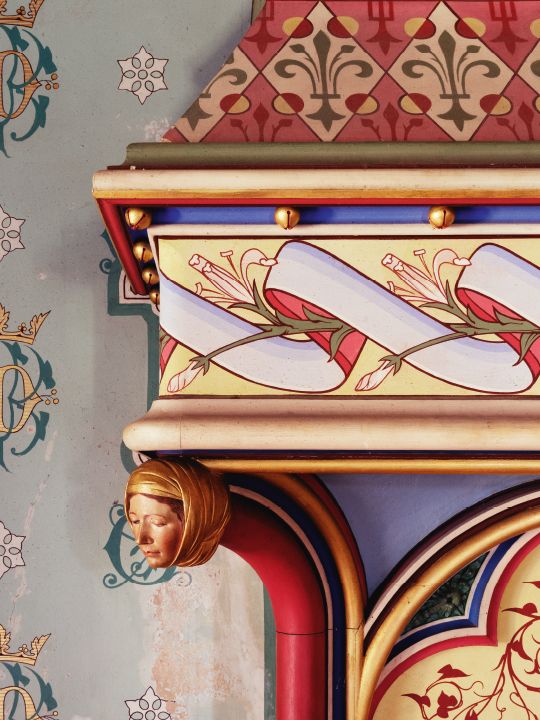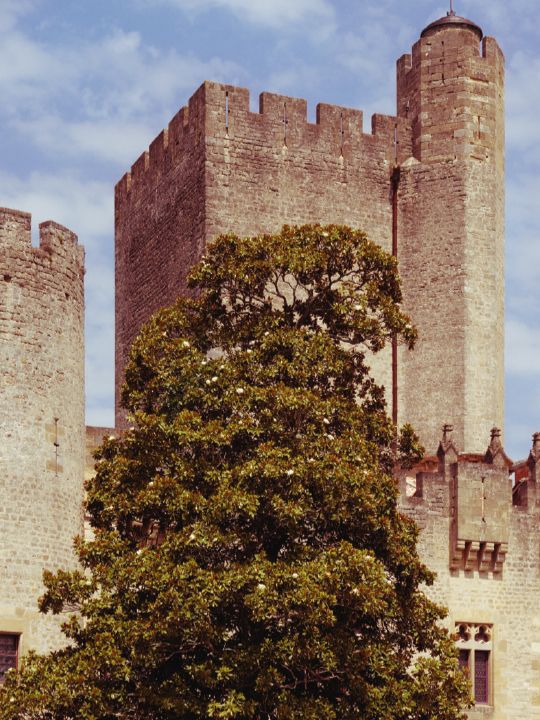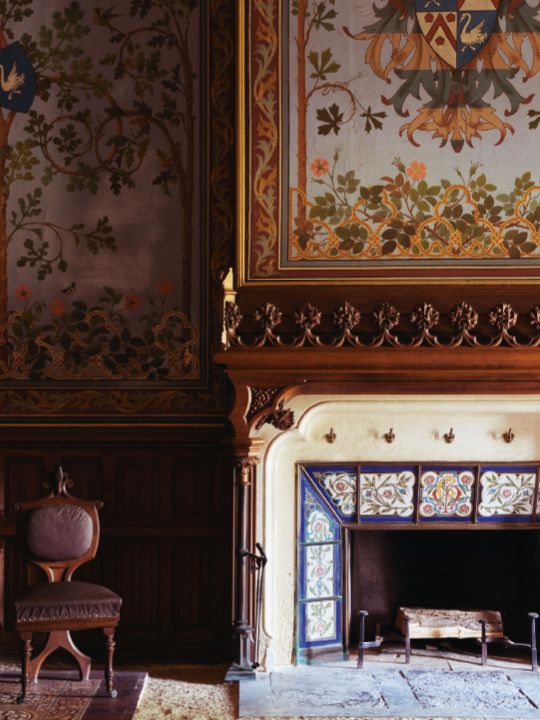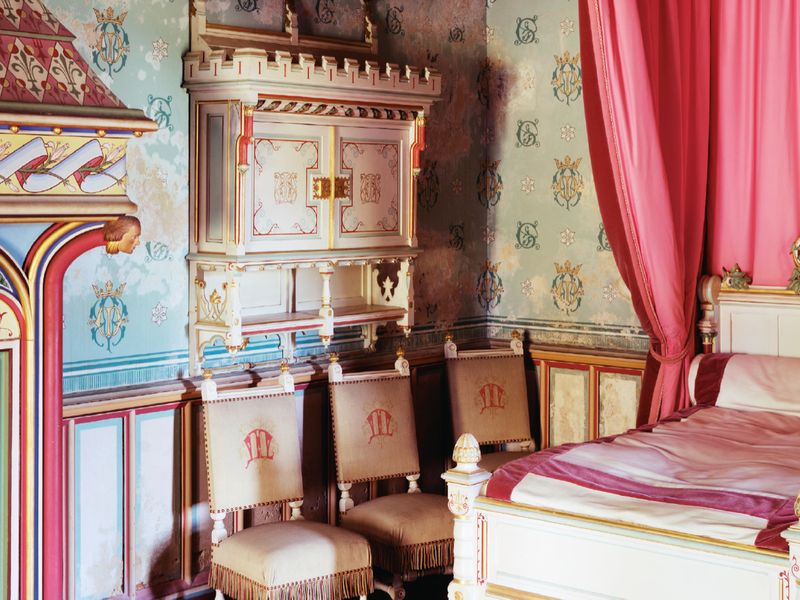
“It's the subliminal castle, the one that children draw, or build with sand, spade and bucket”, the master of Roquetaillade castle, Sébastien de Baritault du Carpia, explained to us, referring to this fortress flanked by its six round towers. And when you think about it, despite the exquisite purity of its outline, it still must have taken an incredible nerve for the ancestors of the current owner to dare to disturb Eugène Viollet-le-Duc. 150 years ago, this man had already been responsible for the restoration of the cathedrals of Notre-Dame de Paris, Reims, Chartres and in the city of Carcassonne. By undertaking the restoration of Pierrefonds castle on behalf of Napoleon III, he was the busiest architect in France. But in the middle of the last century, the former inhabitants of Roquetaillade, the Marquis of Mauvesin and his wife, were determined to “live out a medieval dream, capable of completing the interior of their dreams down to the very last details”, to repeat the words of aesthete Philippe Jullian. As for Viollet-le-Duc, with this fabulous private construction site, he would finally be able to put his decorative talents into practice and imposer his own personal style without restraint.

According to local legend, Charlemagne was the first host of honour of this rocky outcrop. He had a fortified moat constructed in wood in order to assemble his army to reach the Pyrennees at the side of his nephew Roland. A stone castle would follow before the construction of the “new castle” in 1306 by Cardinal Gaillard de La Motte, this heir to lords who occasionally succumbed to the plundering of cattle.
The new fortress was largely indebted to the latter's uncle, who had just been elected Pope under the name of Clément V. The new papal ruler would then gift his five nephews with five citadels, which were known as the "Châteaux Clémentins". His name also appears in Dante's Inferno, whose author hated him for his greed and his slavering servility to King Philippe le Bel. This Pope's hunger for wealth would have so few limits that his "physicians" came up with the idea of relieving him of his misery by having him ingest crushed emeralds. In the centuries that followed, Roquetaillade castle was be more or less spared. Richelieu forgot about it in his series of dismantlements. During the Revolution, the demolishers sent by the dreaded Jean-Lambert Tallien destroyed only one end of the keep, as they were rendered incapable after a long visit to the wine cellar. So that the fortress was practically intact upon the arrival of Viollet-le-Duc in the year of Our Lord 1860. The colossal income that the Marquis de Mauvesin had just received thanks to his vineyards in the Médoc would be used to finance the construction work. In his fabulous reinterpretation of medieval times, Viollet-le-Duc sent for his best craftsmen from Paris for these quatrefoil openings, the merlons mounted on parapets, the machicolation crowned by pinnacles and the drawbridge made to work once more. Or the stone cut in the shapes of swans, bats, a cock with the tail of a fish or basil, a creature dear to readers of Harry Potter. The gargoyles are reminiscent of Notre-Dame and the large staircase a project rejected by the Paris Opera. Thanks to its interior, Roquetaillade castle is still the sole restoration project to be finished in its entirety by Viollet-le-Duc.

The castle displays a freedom that interwines tracery and flowering heraldry that would soone inspire Horta, Guimard or Gaudí. In the dining room, the artist designed the furnishings and adapted the Middle Ages to modern comforts. The chairs were comfortably reupholstered and fitted with castors so that they could be moved around easily. During the German occupation, this extravagant furniture managed to avoid the pillaging thanks to the tenacious personality of Baroness Moncheuil, also known as Aunt Marthe. When the German soldiers tried to take the large table, the imposing baroness laid down on top of it, exclaiming: “If you want to take the table, then you will have to take me with it!” The soldiers looked on it horror at the strength of the rebellious Baroness before abandoning their loot.
A construction site in ruins
The troubadour style of Viollet-le-Duc reaches its climax in the pink room. At the head of the four-poster bed, decorated with the “monogram” of the Galard and Mauvesin families, Papal crosses are a reminder of the sulphurous ancestor. The ceilings, with their triangular or hexagonal motifs, combined in the form of a star, evoke Oriental mysteries or Moorish Spain. Benches were sacrificed with preference to the “padded” style that was popular under the empire of Napoleon III. A fascinating detail bears witness to the absolute freedom of the architect. On the hood of the fireplace can be seen two angelic musicians with multicoloured wings, a Republican overhang that would scarcely have been approved under the iron rule of Napoleon III. The war of 1870 would interrupt the works. After the exile of Viollet-le-Duc in Switzerland, Edmond Duthoit, given the nickname by the master as his “young aide-de-camp”, completed the interior of the chapel inspired by a cathedral in Sicily. However, after fifteen years of work and vast expenditure, the Mauvesin had been bled dry. They had to abort completion of the ornamentation in the “synodal” room, 200 square metres and 10 metres high, which they had planned to decorate in a fashion worthy of a Wagner opera.

Today, Sébastien de Baritault, still in possession of Viollet-le-Duc's plans, has brought in craftsmen to finish the great work of his ancestors. He reminds us that in 1956, his family briefly put the castle up for sale, just before it was opened to the public, thus saving this gem that has been in their family since 1306. “I would not like to be the one to break the chain”, muses the descendant of Cardinal Gaillard de La Motte.


